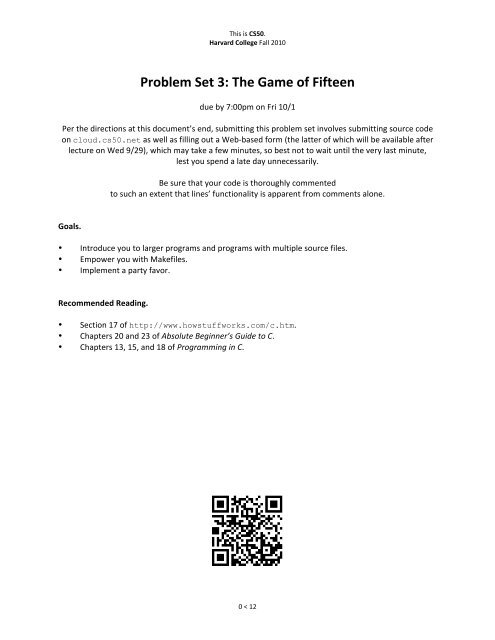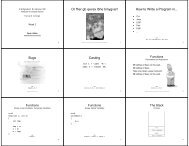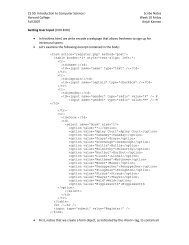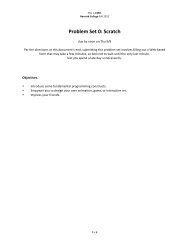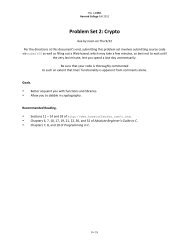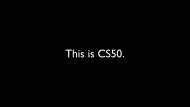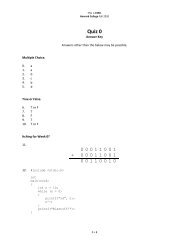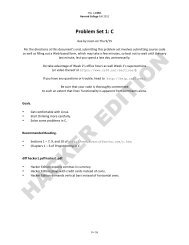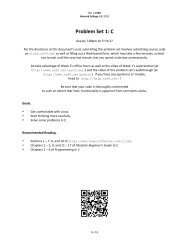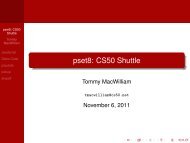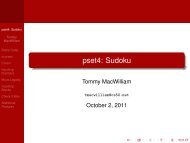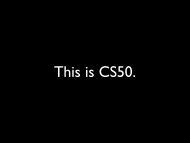Problem Set 3: The Game of Fifteen - This is CS50.
Problem Set 3: The Game of Fifteen - This is CS50.
Problem Set 3: The Game of Fifteen - This is CS50.
You also want an ePaper? Increase the reach of your titles
YUMPU automatically turns print PDFs into web optimized ePapers that Google loves.
<strong>Th<strong>is</strong></strong> <strong>is</strong> <strong>CS50.</strong> <br />
Harvard College Fall 2010 <br />
<strong>Problem</strong> <strong>Set</strong> 3: <strong>The</strong> <strong>Game</strong> <strong>of</strong> <strong>Fifteen</strong> <br />
due by 7:00pm on Fri 10/1 <br />
Per the directions at th<strong>is</strong> document’s end, submitting th<strong>is</strong> problem set involves submitting source code <br />
on cloud.cs50.net as well as filling out a Web-‐based form (the latter <strong>of</strong> which will be available after <br />
lecture on Wed 9/29), which may take a few minutes, so best not to wait until the very last minute, <br />
lest you spend a late day unnecessarily. <br />
Be sure that your code <strong>is</strong> thoroughly commented <br />
to such an extent that lines’ functionality <strong>is</strong> apparent from comments alone. <br />
Goals. <br />
• <br />
• <br />
• <br />
Introduce you to larger programs and programs with multiple source files. <br />
Empower you with Makefiles. <br />
Implement a party favor. <br />
Recommended Reading. <br />
• <br />
• <br />
• <br />
Section 17 <strong>of</strong> http://www.howstuffworks.com/c.htm. <br />
Chapters 20 and 23 <strong>of</strong> Absolute Beginner’s Guide to C. <br />
Chapters 13, 15, and 18 <strong>of</strong> Programming in C. <br />
0 < 12
<strong>Th<strong>is</strong></strong> <strong>is</strong> <strong>CS50.</strong> <br />
Harvard College Fall 2010 <br />
Academic Honesty. <br />
All work that you do toward fulfillment <strong>of</strong> th<strong>is</strong> course’s expectations must be your own unless <br />
collaboration <strong>is</strong> explicitly allowed in writing by the course’s instructor. Collaboration in the completion <br />
<strong>of</strong> problem sets <strong>is</strong> not permitted unless otherw<strong>is</strong>e stated by some problem set’s specification. <br />
Viewing or copying another individual’s work (even if left by a printer, stored in an executable directory, <br />
or accidentally shared in the course’s virtual terminal room) or lifting material from a book, website, or <br />
other source—even in part—and presenting it as your own constitutes academic d<strong>is</strong>honesty, as does <br />
showing or giving your work, even in part, to another student. Similarly <strong>is</strong> dual subm<strong>is</strong>sion academic <br />
d<strong>is</strong>honesty: you may not submit the same or similar work to th<strong>is</strong> course that you have submitted or will <br />
submit to another. Nor may you provide or make available solutions to problem sets to individuals who <br />
take or may take th<strong>is</strong> course in the future. Moreover, subm<strong>is</strong>sion <strong>of</strong> any work that you intend to use <br />
outside <strong>of</strong> the course (e.g., for a job) must be approved by the staff. <br />
You are welcome to d<strong>is</strong>cuss the course’s material with others in order to better understand it. You may <br />
even d<strong>is</strong>cuss problem sets with classmates, but you may not share code. In other words, you may <br />
communicate with classmates in Engl<strong>is</strong>h, but you may not communicate in, say, C. If in doubt as to the <br />
appropriateness <strong>of</strong> some d<strong>is</strong>cussion, contact the course’s instructor. <br />
You may turn to the Web for instruction beyond the course’s lectures and sections, for references, and <br />
for solutions to technical difficulties, but not for outright solutions to problems on problem sets or your <br />
own final project. However, failure to cite (as with comments) the origin <strong>of</strong> any code or technique that <br />
you do d<strong>is</strong>cover outside <strong>of</strong> the course’s lectures and sections (even while respecting these constraints) <br />
and then integrate into your own work may be considered academic d<strong>is</strong>honesty. <br />
All forms <strong>of</strong> academic d<strong>is</strong>honesty are dealt with harshly. If the course refers some matter to the <br />
Admin<strong>is</strong>trative Board and the outcome for some student <strong>is</strong> Warn, Admon<strong>is</strong>h, or D<strong>is</strong>ciplinary Probation, <br />
the course reserves the right to impose local sanctions on top <strong>of</strong> that outcome for that student that may <br />
include, but not be limited to, a failing grade for work submitted or for the course itself. <br />
Grades. <br />
Your work on th<strong>is</strong> problem set will be evaluated along three primary axes. <br />
Correctness. To what extent <strong>is</strong> your code cons<strong>is</strong>tent with our specifications and free <strong>of</strong> bugs? <br />
Design. To what extent <strong>is</strong> your code written well (i.e., clearly, efficiently, elegantly, and/or logically)? <br />
Style. To what extent <strong>is</strong> your code readable (i.e., commented and indented with variables aptly named)? <br />
1 < 12
<strong>Th<strong>is</strong></strong> <strong>is</strong> <strong>CS50.</strong> <br />
Harvard College Fall 2010 <br />
Getting Started. <br />
SSH to cloud.cs50.net and execute the command below. 1<br />
cp -r ~cs50/pub/src/psets/pset3 ~<br />
That command will copy the staff’s pset3/ directory, inside <strong>of</strong> which <strong>is</strong> some “d<strong>is</strong>tribution code,” <br />
files (and subdirectories) that you’ll need for th<strong>is</strong> problem set, into your own home directory. <strong>The</strong> <br />
-r switch triggers a “recursive” copy. Navigate your way to your copy by executing the command <br />
below. <br />
cd ~/pset3/<br />
If you l<strong>is</strong>t the contents <strong>of</strong> your current working directory (remember how?), you should see the <br />
below. If you don’t, don’t hesitate to ask the staff for ass<strong>is</strong>tance. <br />
fifteen/ find/<br />
As th<strong>is</strong> output implies, your work for th<strong>is</strong> problem set will be organized within two subdirectories. <br />
<br />
Don’t forget about help.cs50.net! Not only can you post questions <strong>of</strong> your own, you can also <br />
search for or browse answers to questions already asked by others. And never fear asking “dumb <br />
questions.” Students’ posts to the course’s bulletin board are anonymized. Only the staff, not <br />
fellow students, will know who you are! 2<br />
Be sure, too, to attend or watch th<strong>is</strong> problem set’s walkthrough, the video for which will be <br />
available at http://www.cs50.net/psets/. <br />
And, <strong>of</strong> course, there are plenty <strong>of</strong> <strong>of</strong>fice hours: http://www.cs50.net/ohs/. <br />
1 Note that there’s a space between pset3 and that last tilde (~), the latter <strong>of</strong> which, recall, represents your home <br />
directory. <br />
2 Thus, only we will make fun. <br />
2 < 12
<strong>Th<strong>is</strong></strong> <strong>is</strong> <strong>CS50.</strong> <br />
Harvard College Fall 2010 <br />
Find. <br />
<br />
Now let’s dive into the first <strong>of</strong> those subdirectories. Execute the command below. <br />
cd ~/pset3/find/<br />
If you l<strong>is</strong>t the contents <strong>of</strong> th<strong>is</strong> directory, you should see the below. <br />
helpers.c helpers.h Makefile find.c generate.c<br />
Wow, that’s a lot <strong>of</strong> files, eh? Not to worry, we’ll walk you through them. <br />
<br />
Implemented in generate.c <strong>is</strong> a program that uses rand to generate a whole bunch <strong>of</strong> <br />
pseudorandom numbers, one per line. (Remember rand from <strong>Problem</strong> <strong>Set</strong> 1?) Go ahead and <br />
compile th<strong>is</strong> program by executing the command below. <br />
make generate<br />
Now run the program you just compiled by executing the command below. <br />
./generate<br />
You should be informed <strong>of</strong> the program’s proper usage, per the below. <br />
Usage: generate n [s]<br />
As th<strong>is</strong> output suggests, th<strong>is</strong> program expects one or two command-‐line arguments. <strong>The</strong> first, n, <strong>is</strong> <br />
required; it indicates how many pseudorandom numbers you’d like to generate. <strong>The</strong> second, s, <strong>is</strong> <br />
optional, as the brackets are meant to imply; if supplied, it represents the value that the <br />
pseudorandom-‐number generator should use as its seed. (Remember from <strong>Problem</strong> <strong>Set</strong> 1 what a <br />
seed <strong>is</strong>?) Go ahead and run th<strong>is</strong> program again, th<strong>is</strong> time with a value <strong>of</strong>, say, 10 for n, as in the <br />
below; you should see a l<strong>is</strong>t <strong>of</strong> 10 pseudorandom numbers. <br />
./generate 10<br />
Run the program a third time using that same value for n; you should see a different l<strong>is</strong>t <strong>of</strong> 10 <br />
numbers. Now try running the program with a value for s too (e.g., 0), as in the below. <br />
./generate 10 0<br />
Now run that same command again: <br />
./generate 10 0<br />
Bet you saw the same “random” sequence <strong>of</strong> ten numbers again? Yup, that’s what happens if you <br />
don’t vary a pseudorandom number generator’s initial seed. <br />
3 < 12
<strong>Th<strong>is</strong></strong> <strong>is</strong> <strong>CS50.</strong> <br />
Harvard College Fall 2010 <br />
<br />
Now take a look at generate.c itself with Nano. (Remember how?) Comments atop that file <br />
explain the program’s overall functionality. But it looks like we forgot to comment the code itself. <br />
Read over the code carefully until you understand each line and then comment our code for us, <br />
replacing each TODO with a phrase that describes the purpose or functionality <strong>of</strong> the <br />
corresponding line(s) <strong>of</strong> code. Realize that a comment flanked with /* and */ can span lines <br />
whereas a comment preceded by // can only extend to the end <strong>of</strong> a line; the latter <strong>is</strong> a feature <strong>of</strong> <br />
C99 (the version <strong>of</strong> C that we’ve been using). If <strong>Problem</strong> <strong>Set</strong> 1 feels like a long time ago, you might <br />
want to read up on rand and srand again at the URLs below. <br />
http://www.cs50.net/resources/cppreference.com/stdother/rand.html<br />
http://www.cs50.net/resources/cppreference.com/stdother/srand.html<br />
Or you can execute the commands below. <br />
man rand<br />
man srand<br />
Once done commenting generate.c, re-‐compile the program to be sure you didn’t break <br />
anything by re-‐executing the command below. <br />
make generate<br />
If generate no longer compiles properly, take a moment to fix what you broke! <br />
Now, recall that make automates compilation <strong>of</strong> your code so that you don’t have to execute gcc <br />
manually along with a whole bunch <strong>of</strong> switches. Notice, in fact, how make just executed a pretty <br />
long command for you, per the tool’s output. However, as your programs grow in size, make <br />
won’t be able to infer from context anymore how to compile your code; you’ll need to start telling <br />
make how to compile your program, particularly when they involve multiple source (i.e., .c) files. <br />
And so we’ll start relying on “Makefiles,” configuration files that tell make exactly what to do. <br />
How did make know how to compile generate in th<strong>is</strong> case? It actually used a configuration file <br />
that we wrote. Using Nano, go ahead and look at the file called Makefile that’s in the same <br />
directory as generate.c. <strong>Th<strong>is</strong></strong> Makefile <strong>is</strong> essentially a l<strong>is</strong>t <strong>of</strong> rules that we wrote for you that <br />
tells make how to build generate from generate.c for you. <strong>The</strong> relevant lines appear below. <br />
generate: generate.c<br />
gcc -ggdb -std=c99 -Wall -Werror -Wformat=0 -o generate generate.c<br />
<strong>The</strong> first line tells make that the “target” called generate should be built by invoking the second <br />
line’s command. Moreover, that first line tells make that generate <strong>is</strong> dependent on <br />
generate.c, the implication <strong>of</strong> which <strong>is</strong> that make will only re-‐build generate on subsequent <br />
runs if that file was modified since make last built generate. Neat time-‐saving trick, eh? In fact, <br />
go ahead and execute the command below again, assuming you haven’t modified generate.c. <br />
make generate<br />
4 < 12
<strong>Th<strong>is</strong></strong> <strong>is</strong> <strong>CS50.</strong> <br />
Harvard College Fall 2010 <br />
You should be informed that generate <strong>is</strong> already up to date. Incidentally, know that the leading <br />
whitespace on that second line <strong>is</strong> not a sequence <strong>of</strong> spaces but, rather, a tab. Unfortunately, <br />
make requires that commands be preceded by tabs, so be careful not to change them to spaces <br />
with Nano (which automatically converts tabs to four spaces), else you may encounter strange <br />
errors! <strong>The</strong> -Werror flag, recall, tells gcc to treat warnings (bad) as though they’re errors <br />
(worse) so that you’re forced (in a good, instructive way!) to fix them. <br />
<br />
Now take a look at find.c with Nano. Notice that th<strong>is</strong> program expects a single command-‐line <br />
argument: a “needle” to search for in a “haystack” <strong>of</strong> values. Once done looking over the code, go <br />
ahead and compile the program by executing the command below. <br />
make find<br />
Notice, per that command’s output, that Make actually executed the below for you. <br />
gcc -ggdb -std=c99 -Wall -Werror -Wformat=0 -o find find.c helpers.c -lcs50 -lm<br />
Notice further that you just compiled a program compr<strong>is</strong>ing not one but two .c files: helpers.c <br />
and find.c. How did make know what to do? Well, again, open up Makefile to see the man <br />
behind the curtain. <strong>The</strong> relevant lines appear below. <br />
find: find.c helpers.c helpers.h<br />
gcc -ggdb -std=c99 -Wall -Werror -Wformat=0 -o find find.c helpers.c -lcs50 -lm<br />
Per the dependencies implied above (after the colon), any changes to find.c, helpers.c, or <br />
helpers.h will compel make to rebuild find the next time it’s invoked for th<strong>is</strong> target. <br />
Go ahead and run th<strong>is</strong> program by executing, say, the below. <br />
./find 13<br />
You’ll be prompted to provide some hay (i.e., some integers), one “straw” at a time. As soon as <br />
you tire <strong>of</strong> providing integers, hit ctrl-‐d to send the program an EOF (end-‐<strong>of</strong>-‐file) character. That <br />
character will compel GetInt from the CS50 Library to return INT_MAX, a constant that, per <br />
find.c, will compel find to stop prompting for hay. <strong>The</strong> program will then look for that needle in <br />
the hay you provided, ultimately reporting whether the former was found in the latter. In short, <br />
th<strong>is</strong> program searches an array for some value. <br />
In turns out you can automate th<strong>is</strong> process <strong>of</strong> providing hay, though, by “piping” the output <strong>of</strong> <br />
generate into find as input. For instance, the command below passes 1,024 pseudorandom <br />
numbers to find, which then searches those values for 13. <br />
./generate 1024 | ./find 13<br />
Alternatively, you can “redirect” generate’s output to a file with a command like the below. <br />
./generate 1024 > numbers.txt<br />
5 < 12
<strong>Th<strong>is</strong></strong> <strong>is</strong> <strong>CS50.</strong> <br />
Harvard College Fall 2010 <br />
You can then redirect that file’s contents as input to find with the command below. <br />
./find 13 < numbers.txt<br />
Let’s fin<strong>is</strong>h looking at that Makefile. Notice the line below. <br />
all: find generate<br />
<strong>Th<strong>is</strong></strong> target implies that you can build both generate and find simply by executing the below. <br />
make all<br />
Even better, the below <strong>is</strong> equivalent (because make builds a Makefile’s first target by default). <br />
make<br />
If only you could whittle th<strong>is</strong> whole problem set down to a single command! Finally, notice these <br />
last lines in Makefile: <br />
clean:<br />
rm -f *.o a.out core find generate<br />
<strong>Th<strong>is</strong></strong> target allows you to delete all files ending in .o or called a.out, core (tsk, tsk), find, or <br />
generate simply by executing the command below. <br />
make clean<br />
Be careful not to add, say, *.c to that last line in Makefile! (Why?) Any line, incidentally, that <br />
begins with # <strong>is</strong> just a comment. <br />
<br />
And now the fun begins! Notice that find.c calls sort, a function declared in helpers.h. <br />
Unfortunately, we forgot to implement that function fully in helpers.c! Take a peek at <br />
helpers.c with Nano, and you’ll see that sort returns immediately, even though find’s main <br />
function does pass it an actual array. To be sure, we could have put the contents <strong>of</strong> helpers.h <br />
and helpers.c in find.c itself. But it’s sometimes better to organize programs into multiple <br />
files, especially when some functions (e.g., sort) are essentially utility functions that might later <br />
prove useful to other programs as well, much like those in the CS50 Library. <br />
Incidentally, recall the syntax for declaring an array. Not only do you specify the array’s type, you <br />
also specify its size between brackets, just as we do for haystack in find.c: <br />
int haystack[HAY_MAX];<br />
6 < 12
<strong>Th<strong>is</strong></strong> <strong>is</strong> <strong>CS50.</strong> <br />
Harvard College Fall 2010 <br />
But when passing an array, you only specify its name, just as we do when passing haystack to <br />
sort in find.c: <br />
sort(haystack, size);<br />
(Why do we also pass in the size <strong>of</strong> that array separately?) <br />
When declaring a function that takes a one-‐dimensional array as an argument, though, you don’t <br />
need to specify the array’s size, just as we don’t when declaring sort in helpers.h (and <br />
helpers.c): <br />
void sort(int values[], int n);<br />
Go ahead and implement sort so that the function actually sorts, from smallest to largest, the <br />
array <strong>of</strong> numbers that it’s passed, in such a way that its running time <strong>is</strong> in O(n 2 ), where n <strong>is</strong> the <br />
array’s size. Odds are you’ll want to implement Bubble Sort or Selection Sort, if only because we <br />
d<strong>is</strong>cussed them in Week 3. Just realize that there’s no one “right” way to implement either <strong>of</strong> <br />
those algorithms; variations abound. In fact, you’re welcome to improve upon them as you see <br />
fit, so long as your implementation remains in O(n 2 ). However, take care not to alter our <br />
declaration <strong>of</strong> sort. Its prototype must remain: <br />
void sort(int values[], int n);<br />
As th<strong>is</strong> return type <strong>of</strong> void implies, th<strong>is</strong> function must not return a sorted array; it must instead <br />
“destructively” sort the actual array that it’s passed by moving around the values therein. As we’ll <br />
d<strong>is</strong>cuss in Week 4, arrays are not passed “by value” but instead “by reference,” which means that <br />
sort will not be passed a copy <strong>of</strong> an array but, rather, the original array itself. <br />
We leave it to you to determine how to test your implementation <strong>of</strong> sort. But don’t forget that <br />
printf and, per Week 3’s second lecture, gdb are your friends. And don’t forget that you can <br />
generate the same sequence <strong>of</strong> pseudorandom numbers again and again by explicitly specifying <br />
generate’s seed. Before you ultimately submit, though, be sure to remove any such calls to <br />
printf, as we like our programs’ outputs just they way they are! <br />
Incidentally, check out Resources on the course’s website for a great little quick-‐reference guide <br />
for gdb. If you’d like to play with the staff’s own implementation <strong>of</strong> find on cloud.cs50.net, <br />
you may execute the below. <br />
~cs50/pub/solutions/pset3/find<br />
<br />
<br />
Need help? Head to help.cs50.net! <br />
Now that sort (presumably) works, it’s time to improve upon search, the other function that <br />
lives in helpers.c. Notice that our version implements “linear search,” whereby search looks <br />
for value by iterating over the integers in array linearly, from left to right. Rip out the lines that <br />
we’ve written and re-‐implement search as binary search, that divide-‐and-‐conquer strategy that <br />
7 < 12
<strong>Th<strong>is</strong></strong> <strong>is</strong> <strong>CS50.</strong> <br />
Harvard College Fall 2010 <br />
we employed in Week 0 in order to search through phone book. 3 You are welcome to take an <br />
iterative or a recursive approach. If you pursue the latter, though, know that you may not change <br />
our declaration <strong>of</strong> search, but you may write a new, recursive function (that perhaps takes <br />
different parameters) that search itself calls. <br />
<strong>The</strong> <strong>Game</strong> Begins. <br />
<br />
And now it’s time to play. <strong>The</strong> <strong>Game</strong> <strong>of</strong> <strong>Fifteen</strong> <strong>is</strong> a puzzle played on a square, two-‐dimensional <br />
board with numbered tiles that slide. <strong>The</strong> goal <strong>of</strong> th<strong>is</strong> puzzle <strong>is</strong> to arrange the board’s tiles from <br />
smallest to largest, left to right, top to bottom, with an empty space in board’s bottom-‐right <br />
corner, as in the below. 4<br />
Sliding any tile that borders the board’s empty space in that space constitutes a “move.” Although <br />
the configuration above depicts a game already won, notice how the tile numbered 12 or the tile <br />
numbered 15 could be slid into the empty space. Tiles may not be moved diagonally, though, or <br />
forcibly removed from the board. <br />
Although other configurations are possible, we shall assume that th<strong>is</strong> game begins with the <br />
board’s tiles in reverse order, from largest to smallest, left to right, top to bottom, with an empty <br />
space in the board’s bottom-‐right corner. If, however, and only if the board contains an odd <br />
number <strong>of</strong> tiles (i.e., the height and width <strong>of</strong> the board are even), the positions <strong>of</strong> tiles numbered <br />
1 and 2 must be swapped, as in the below. 5 <strong>The</strong> puzzle <strong>is</strong> solvable from th<strong>is</strong> configuration. <br />
3 No need to tear anything in half. <br />
4 Figure from http://en.wikipedia.org/wiki/<strong>Fifteen</strong>_puzzle. <br />
5 Figure adapted from http://en.wikipedia.org/wiki/<strong>Fifteen</strong>_puzzle. <br />
8 < 12
<strong>Th<strong>is</strong></strong> <strong>is</strong> <strong>CS50.</strong> <br />
Harvard College Fall 2010 <br />
<br />
Navigate your way to ~/pset3/fifteen/, and take a look at fifteen.c with Nano. Within th<strong>is</strong> <br />
file <strong>is</strong> an entire framework for <strong>The</strong> <strong>Game</strong> <strong>of</strong> <strong>Fifteen</strong>. <strong>The</strong> challenge up next <strong>is</strong> to complete th<strong>is</strong> <br />
game’s implementation. <br />
But first go ahead and compile the framework. (Can you figure out how?) And, even though it’s <br />
not yet fin<strong>is</strong>hed, go ahead and run the game. (Can you figure out how?) <br />
Phew. It appears that the game <strong>is</strong> at least partly functional. Granted, it’s not much <strong>of</strong> a game yet. <br />
But that’s where you come in. <br />
Read over the code and comments in fifteen.c and then answer the questions below in <br />
questions.txt. <br />
i. Besides 4 × 4 (which are <strong>The</strong> <strong>Game</strong> <strong>of</strong> <strong>Fifteen</strong>’s dimensions), what other dimensions does <br />
the framework allow? <br />
ii. With what sort <strong>of</strong> data structure <strong>is</strong> the game’s board represented? <br />
iii. What function <strong>is</strong> called to greet the player at game’s start? <br />
iv. What functions do you apparently need to implement? <br />
<br />
Alright, get to it, implement th<strong>is</strong> game. Remember, take “baby steps.” Don’t try to bite <strong>of</strong>f the <br />
entire game at once. Instead, implement one function at a time and be sure that it works before <br />
forging ahead. In particular, we suggest that you implement the framework’s functions in th<strong>is</strong> <br />
order: init, draw, move, won. Any design dec<strong>is</strong>ions not explicitly prescribed herein (e.g., how <br />
much space you should leave between numbers when printing the board) are intentionally left to <br />
you. Presumably the board, when printed, should look something like the below, but we leave it <br />
to you to implement your own v<strong>is</strong>ion. <br />
15 14 13 12<br />
11 10 9 8<br />
7 6 5 4<br />
3 1 2 _<br />
Incidentally, recall that the positions <strong>of</strong> tiles numbered 1 and 2 should only start <strong>of</strong>f swapped (as <br />
they are in the 4 × 4 example above) if the board has an odd number <strong>of</strong> tiles (as does the 4 × 4 <br />
example above). If the board has an even number <strong>of</strong> tiles, those positions should not start <strong>of</strong>f <br />
swapped. And so they do not in the 3 × 3 example below: <br />
8 7 6<br />
5 4 3<br />
2 1 _<br />
To test your implementation <strong>of</strong> fifteen, you can certainly try playing it. (Know that you can <br />
force your program to quit by hitting ctrl-‐c.) Be sure that you (and we) cannot crash your <br />
9 < 12
<strong>Th<strong>is</strong></strong> <strong>is</strong> <strong>CS50.</strong> <br />
Harvard College Fall 2010 <br />
program, as by providing bogus tile numbers. And know that, much like you automated input into <br />
find, so can you automate execution <strong>of</strong> th<strong>is</strong> game. In fact, in ~cs50/pub/tests/pset3/ are <br />
3x3.txt and 4x4.txt, winning sequences <strong>of</strong> moves for a 3 × 3 board and a 4 × 4 board, <br />
respectively. To test your program with, say, the first <strong>of</strong> those inputs, execute the below. <br />
./fifteen 3 < ~cs50/pub/tests/pset3/3x3.txt<br />
Feel free to tweak the appropriate argument to usleep to speed up animation. In fact, you’re <br />
welcome to alter the aesthetics <strong>of</strong> the game. For (optional) fun with “ANSI escape sequences,” <br />
including color, take a look at our implementation <strong>of</strong> clear and check out the URL below for more <br />
tricks. <br />
http://<strong>is</strong>the.com/chongo/tech/comp/ansi_escapes.html<br />
You’re welcome to write your own functions and even change the prototypes <strong>of</strong> functions we <br />
wrote. But we ask that you not alter the flow <strong>of</strong> logic in main itself so that we can automate some <br />
tests <strong>of</strong> your program once submitted. In particular, main must only returns 0 if and when the <br />
user has actually won the game; non-‐zero values should be returned in any cases <strong>of</strong> error, as <br />
implied by our d<strong>is</strong>tribution code. If in doubt as to whether some design dec<strong>is</strong>ion <strong>of</strong> yours might <br />
run counter to the staff’s w<strong>is</strong>hes, simply contact your teaching fellow. <br />
If you’d like to play with the staff’s own implementation <strong>of</strong> fifteen on cloud.cs50.net, you <br />
may execute the below. <br />
~cs50/pub/solutions/pset3/fifteen<br />
If you’d like to see an even fancier version, one so good that it can play itself, try out our solution <br />
to the Hacker Edition by executing the below. <br />
~cs50/pub/solutions/hacker3/fifteen<br />
Instead <strong>of</strong> typing a number at the game’s prompt, type GOD instead. Neat, eh? 6<br />
<br />
help.cs50.net! <br />
How to Submit. <br />
In order to submit th<strong>is</strong> problem set, you must first execute a command on cloud.cs50.net and then <br />
submit a (brief) form online; the latter will be posted after lecture on Wed 9/29. <br />
<br />
SSH to cloud.cs50.net, if not already there, and then execute: <br />
cd ~/pset3<br />
6 To be clear, implementation <strong>of</strong> God Mode <strong>is</strong> part <strong>of</strong> th<strong>is</strong> problem set’s Hacker Edition. You don’t need to <br />
implement God Mode for th<strong>is</strong> standard edition! But it’s still pretty neat, eh? <br />
10 < 12
<strong>Th<strong>is</strong></strong> <strong>is</strong> <strong>CS50.</strong> <br />
Harvard College Fall 2010 <br />
If informed that there <strong>is</strong> “no such file or directory,” odds are you skipped some step(s) earlier! Not <br />
a problem, we’ll help you fix in a moment. If the command indeed works, proceed to execute th<strong>is</strong> <br />
command next: <br />
ls<br />
At a minimum, you should see fifteen and find. If not, odds are you skipped some more steps <br />
earlier! If you do see those files, you’re ready to submit your source code to us: 7<br />
~cs50/pub/bin/submit pset3<br />
That command will essentially copy your entire ~/pset3 directory into CS50’s own account, <br />
where your TF will be able to access it. You’ll know that the command worked if you are informed <br />
that your “work HAS been submitted.” If you instead encounter an error that doesn’t appear to <br />
be a m<strong>is</strong>take on your part, do try running the command one or more additional times. (<strong>The</strong> <br />
submit program’s a bit old and annoyingly flakey.) But if informed that your “work HAS been <br />
submitted,” it indeed has. <br />
Now, if you instead see some message informing you that your code <strong>is</strong> not where it should be, <br />
you’ll need to fix that before you submit. Review the last two pages <strong>of</strong> <strong>Problem</strong> <strong>Set</strong> 1’s spec for <br />
some tips! <br />
<br />
Anytime after lecture on Wed 9/29 but before th<strong>is</strong> problem set’s deadline, head to the URL below <br />
where a short form awaits: <br />
http://www.cs50.net/psets/3/<br />
If not already logged in, you’ll be prompted to log into the course’s website. <br />
Once you have submitted that form (as well as your source code), you are done! <br />
<strong>Th<strong>is</strong></strong> was <strong>Problem</strong> <strong>Set</strong> 3. <br />
7 Note that there <strong>is</strong> no slash between th<strong>is</strong> tilde (~) and cs50. <br />
11 < 12


